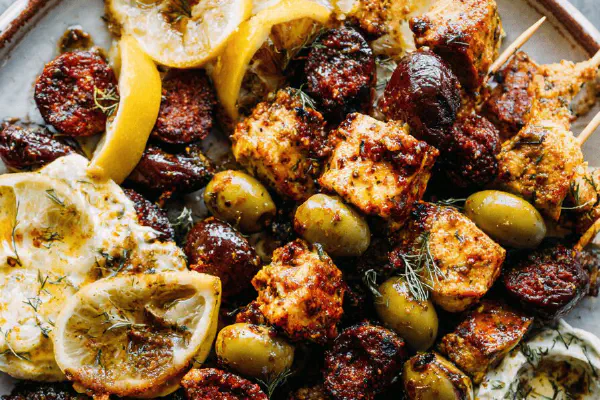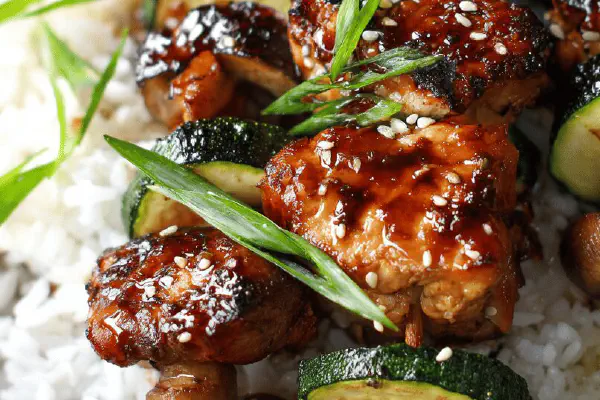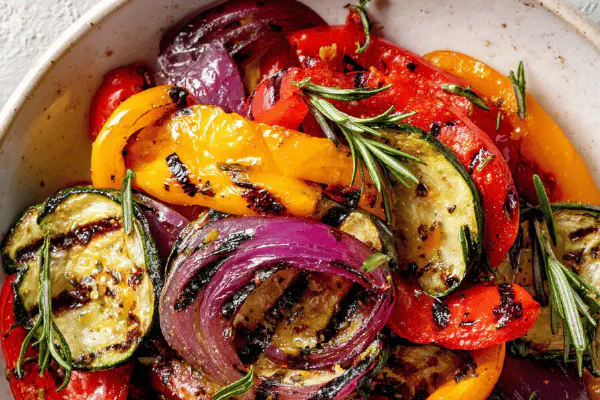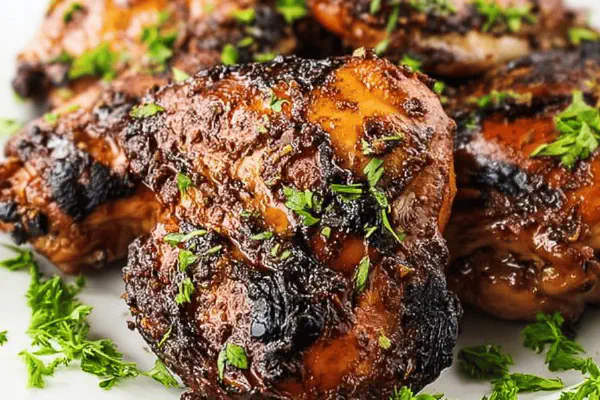Chicken Chorizo Olive Skewers
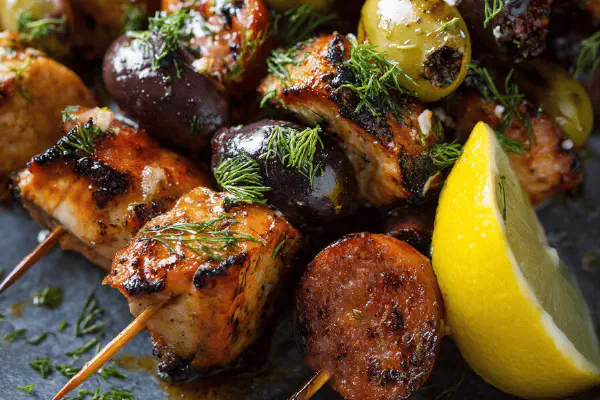
By Emma
Certified Culinary Professional
Ingredients
- 700 g (about 1 ⅓ lb) boneless skinless chicken thighs or breasts, cubed (~34 cubes)
- 35 ml (2 ½ tbsp) olive oil
- 3 ml (⅗ tsp) crushed fennel seeds
- 3 ml (⅗ tsp) cracked black peppercorns
- 3 ml (⅗ tsp) curry powder
- 1.5 ml (½ tsp) kosher salt
- 32 slices chorizo sausage, roughly 1 cm (½ in) thick
- 32 green olives, pitted and rinsed
- 8 metal or soaked wooden skewers
- 1 lemon, quartered (optional garnish)
- Tzatziki sauce, as desired (optional)
- Hummus, as desired (optional)
About the ingredients
Method
- Mix chicken cubes with olive oil, spices including fennel seeds, cracked pepper, curry powder, and kosher salt in a bowl. Toss gently to coat all pieces evenly. Let rest 10 minutes if you have time, but no more.
- Thread skewers alternating chunks of chicken (~4 per skewer), slices of chorizo (6 per skewer), and green olives (6 per skewer). The order matters little; I stagger them randomly for even heat and color.
- Preheat grill to high, oil grates well to avoid sticking. Lay skewers over direct heat; listen for sizzle—sudden, sharp, not soft hissing.
- Grill 3-4 minutes per side, watch color turn from pale pink to opaque ivory with seared edges. Avoid charring; burnt bits smell bitter, kill those bites.
- Shift skewers to cooler spot (indirect heat zone). Close lid, continue cooking 10-12 minutes. Test doneness by gently pressing chicken pieces: firm yet springy. Internal temp around 74°C (165°F) if you insist on thermometers.
- Remove skewers, allow rest 5 minutes on warm platter. Meat juices redistribute, keeps bites juicy.
- Serve with lemon wedges, sprinkle juice over hot skewers. Offer tzatziki or hummus on the side. Creamy sauces cut through the spice and salt nicely.
- Cleanup tip: If using wooden skewers, soak at least 30 minutes before to prevent burning.
Cooking tips
Chef's notes
- 💡 Layer skewers with chunks of chicken and slices of chorizo, alternate with olives. Don’t cram pieces tightly; heat needs to circulate or raw bits sneak in. Use metal or soaked wooden skewers; dry wood burns, bitter taste sneaks in smoke. Thread gently, avoid piercing meat multiple times to keep juices sealed in. Watch grill sounds; sizzling sharp, then softer means move to indirect heat. Time over flames varies—feel fibers firm up, spring back to touch. Colors shift pale pink to ivory, edges seared lightly.
- 💡 Resting meat after grilling is crucial. Let skewers sit five minutes, juices redistribute. Skip resting and you lose moisture when cutting or biting. Use warm platter, cover loosely if needed. This quiet time changes bite—firmer but juicier. Skewers get more forgiving if you rushed initial cooking or your fire flamed unpredictably. Skewers cool quickly under fan or window, avoid chilling immediately. Rest room temp, no heat traps but not cold either.
- 💡 Spices matter; cracked fennel seeds add crunch and anise aroma lost if powdered. Curry powder quantity nudged up on purpose; helps curry tie fennel, pepper, chorizo smoke. Use kosher salt, coarser grain; easier to control saltiness on meat chunks. If no chorizo, try smoked andouille or kielbasa for robust flavor variations. Each sausage type shifts overall spice balance; adjust curry/pepper accordingly. Olive oil is neutral base, could swap for grapeseed but lose subtle fruity hints.
- 💡 Grill prep is key—clean grates, oil well to avoid sticking. Preheat high for sear, listen for telltale sizzles. Move skewers quickly once sear forms, avoid flames licking meat. High heat sears outsides; indirect zone slowly finishes cooking without drying. Use tongs gently, press chicken pieces to check doneness; feels firm yet with natural spring. If too soft or squishy, still raw. Thermometer reading 74°C (165°F) good backup but mostly rely on feel and sight.
- 💡 Skewer handling tips: soak wooden skewers at least 30 minutes or burn risk and bitter smoke. Turn skewers with tongs, don’t stab meat repeatedly; juices escape through holes causing dryness. Alternate protein and fat slices to keep heat circulation balanced. Don’t overbunch olives or slices; too dense blocks heat, undercooks interior. Lemon wedges aren’t just garnish; squirt juice over hot meat after resting to brighten and cut fat. Serve creamy tzatziki or hummus on side for texture contrast and temperature balance.
Common questions
How to know when chicken cubes are done?
Press with tongs, springy but firm. Color changes pale pink to opaque ivory. If still soft, wait longer. Thermometer reads 74°C but don’t rely only on gadget. Sizzle and smell give clues too.
Can I use other sausages instead of chorizo?
Yes, smoked andouille or kielbasa works. Different spices, adjust curry and pepper. Texture changes. Avoid too fine sausages that turn mushy on grill. Keep slices about half-inch thick for sear time.
What if skewers catch fire on grill?
Move them immediately to indirect heat zone. Keep soaked skewers to prevent flare-ups. Oil grates well beforehand. Avoid heavy sugar-based marinades that drip and burn. Control flames with grill lid and flame height.
How to store leftovers?
Cool quickly, fridge in airtight container. Reheat gently to avoid dryness, oven low temp or covered pan on stove. Skewers can be frozen but lose some texture on thaw. Use within 2-3 days for best texture. Avoid microwave for juicy bite.
